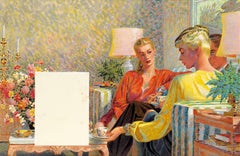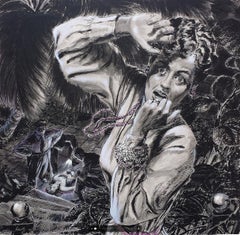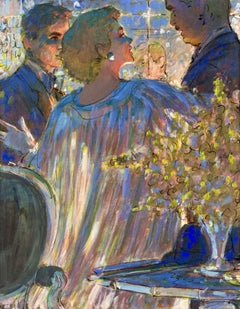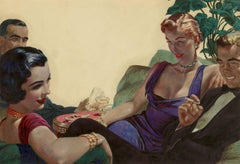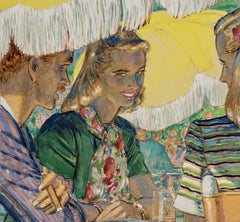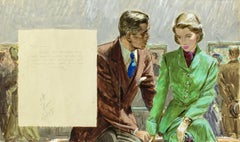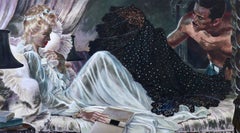Edwin Georgi Art
to
1
4
2
2
Overall Width
to
Overall Height
to
8
3
4
1
1
5
3
8
7
7
3
2
1
1
1
1
8
8
7
3
3
8
7,786
4,999
2,504
1,374
4
8
Artist: Edwin Georgi
"The Clever Sister.", Story Illustration for Woman's Home Companion
By Edwin Georgi
Located in Fort Washington, PA
Date: December, 1946
Medium: Gouache and Graphite on Board
Dimensions: 17.50" x 26.75"
Signature: Unsigned
"The Clever Sister." Illustration for the first part of the story of the s...
Category
1940s Edwin Georgi Art
Materials
Gouache, Board, Graphite
Saturday Evening Post Illustration. “ The Devil’s Stronghold” Original Magazine
By Edwin Georgi
Located in Miami, FL
The work is mostly black and white to indicate that this is a night scene. On closer inspection, you will see areas of magenta and ivory throughout
The publisher's label on verso ide...
Category
1960s American Modern Edwin Georgi Art
Materials
India Ink, Gouache, Pencil
Invitation to Murder
By Edwin Georgi
Located in Fort Washington, PA
Meidum: Tempera and Gouache on Paper
Signature: Unsigned
Story Illustration for "Invitation to Murder" by Leslie Ford, published in The Saturday Evening Post, July 17, 1954, page 19
Category
1950s Edwin Georgi Art
Materials
Tempera, Paper, Gouache
The Social Hour
By Edwin Georgi
Located in Fort Washington, PA
Signed Lower Left
Probable Redbook Magazine interior illustration, circa 1950
Category
1950s Edwin Georgi Art
Materials
Gouache, Board
Webster Cigars at Florida's Boca Raton Club, Study for Advertisement
By Edwin Georgi
Located in Fort Washington, PA
Medium: Watercolor and Gouache on Paper laid on Board
Signature: Signed and Dated on the Reverse
Study for advertisement promoting Webster Cigars at Florida's Boca Raton Club, circa...
Category
1940s Edwin Georgi Art
Materials
Paper, Watercolor, Gouache, Board
Couple at Museum
By Edwin Georgi
Located in Fort Washington, PA
Medium: Watercolor on Paper
Signature: Unsigned
Category
1940s Edwin Georgi Art
Materials
Paper, Watercolor
Man on Floor Illustration
By Edwin Georgi
Located in Miami, FL
Man on Floor Illustration
ca. 1950–1959
Paintings, gouache on board
8 x 26.25 in. (20.3 x 66.7 cm.)
Modern
Magazine Story Illustration
Heritage, Morris Weiss CollectionSunning work w...
Category
1950s American Realist Edwin Georgi Art
Materials
Gouache
"Invitation to Murder, " Preliminary Studies
By Edwin Georgi
Located in Fort Washington, PA
Medium: Gouache, Charcoal and Ink
Signature: Unsigned
Invitation to Murder, preliminary studies.
Finished piece featured in The Saturday Evening Post, July 17, 1954
Category
1950s Edwin Georgi Art
Materials
Charcoal, Ink, Gouache
Related Items
nude painting woman watercolour
Located in Roma, GB
erotic portrait nu
naked woman
after the bath
Original tempera watercolor on paper
51x41cm
hand signed
Category
21st Century and Contemporary Contemporary Edwin Georgi Art
Materials
Paper, Tempera, Watercolor
Blue boy
Located in Roma, GB
watercolour on paper
unique artwork
one-of-a-kind
Category
21st Century and Contemporary Abstract Expressionist Edwin Georgi Art
Materials
Paper, Tempera, Watercolor
Wish, a Surrealistic Watercolor Landscape with a Floating Wishbone the the Sky
By Melanie Vote
Located in New York, NY
This stunning piece by Melanie Vote exemplifies her signature style of subtly surreal landscapes. Featuring a traditional old-master type landscape, the work takes an unexpected turn...
Category
2010s Surrealist Edwin Georgi Art
Materials
Paper, Watercolor, Graphite
"The Salamander Pond" (2024) by Deb Komitor, Original Painting
By Deb Komitor
Located in Denver, CO
"The Salamander Pond" (2024) by Deb Komitor (United States) is a handmade landscape oil painting that is ready to hang.
Deb Komitor was born and raised in Ohio and now resides in C...
Category
21st Century and Contemporary Impressionist Edwin Georgi Art
Materials
Paper, Gouache, Board
H 10 in W 10 in D 1.5 in
Simka Simkhovitch WPA W/C Painting Gouache American Modernist Beach Scene Nude
By Simka Simkhovitch
Located in Surfside, FL
Simka Simkhovitch (Russian/American 1893 - 1949)
This came with a small grouping from the artist's family, some were hand signed some were not.
These were studies for larger paintings.
This is a watercolor and gouache beach scene three young men bathing...
Category
1930s American Modern Edwin Georgi Art
Materials
Gouache, Board, Watercolor
Tulips. Gouache Painting, Abstract, Figurative, Flowers, Polish art
By Bożena Lesiak
Located in Warsaw, PL
Contemporary floral still life figurative gouache on paper painting by Polish artist Bozena Lesiak. Painting is in a small format. Bozena Lesiak's art embodies beauty of nature and i...
Category
2010s Contemporary Edwin Georgi Art
Materials
Paper, Gouache
Simka Simkhovitch WPA Artist Painting Gouache American Modernist Beach Scene
By Simka Simkhovitch
Located in Surfside, FL
Simka Simkhovitch (Russian/American 1893 - 1949)
This came with a small grouping from the artist's family, some were hand signed some were not.
These were studies for larger paintings.
Simka Simkhovitch (Симха Файбусович Симхович) (aka Simka Faibusovich Simkhovich) (Novozybkov, Russia May 21, 1885 O.S./June 2, 1885 N.S.—Greenwich, Connecticut February 25, 1949) was a Ukrainian-Russian Jewish artist and immigrant to the United States. He painted theater scenery in his early career and then had several showings in galleries in New York City. Winning Works Progress Administration (WPA) commissions in the 1930s, he completed murals for the post offices in Jackson, Mississippi and Beaufort, North Carolina. His works are in the permanent collections of the Dallas Museum of Art, the National Museum of American Art and the Whitney Museum of American Art. Born outside Kyiv (Petrograd Ukraine) into a Jewish family who owned a small department store. During a severe case of measles when he was seven, Simcha Simchovitch sketched the views outside his window and decided to become an artist, over his father's objections. Beginning in 1905, he studied at the Grekov Odessa Art School and upon completion of his studies in 1911 received a recommendation to be admitted to the Imperial Academy of Arts. Though he enrolled to begin classes in architecture, painting, and sculpture at the Imperial Academy, he was dropped from the school roster in December because of the quota on the number of Jewish students and drafted into the army. Simchovitch served as a private in the 175th Infantry Regiment Baturyn [ru] until his demobilization in 1912. Re-enrolling in the Imperial Academy, he audited classes.
Simka Simkhovitch exhibited paintings and sculptures in 1918 as part of an exhibition of Jewish artists and in 1919 placed 1st in the competition "The Great Russian Revolution" with a painting called "Russian Revolution" which was hung in the State Museum of Revolution. In 1922, Simkha Simkhovitch exhibited at the International Book Fair in Florence (Italian: Fiera Internazionale del Libro di Firenze). In 1924, Simkhovitch came to the United States to make illustrations for Soviet textbooks and decided to immigrate instead. Initially he supported himself by doing commercial art and a few portrait commissions. In 1927, he was hired to paint a screen for a scene in the play "The Command to Love" by Fritz Gottwald and Rudolph Lothar which was playing at the Longacre Theatre on Broadway. Art dealers began clamoring for the screen and Simkhovitch began a career as a screen painter for the theater. Catching the attention of the screenwriter, Ernest Pascal, he worked as an illustrator for Pascal, who then introduced him to gallery owner, Marie Sterner. Simkhovitch's works appeared at the Marie Sterner Gallery beginning with a 1927 exhibit and were repeated the following year. Simkhovitch had an exhibit in 1929 at Sterner's on circus paintings. In 1931, he held a showing of works at the Helen Hackett Gallery, in New York City and later that same year he was one of the featured artists of a special exhibit in San Francisco at the California Palace of the Legion of Honor in Lincoln Park. The exhibit was coordinated by Marie Sterner and included four watercolors, including one titled "Nudes". He is of the generation of Russian Soviet artists such as Isaac Pailes, Serge Charchoune, Marc Chagall, Chana Orloff, Isaac Ilyich Levitan, and Ossip Zadkine.
In 1936, Simkhovitch was selected to complete the mural for the WPA Post office project in Jackson, Mississippi. The mural was hung in the post office and courthouse in 1938 depicted a plantation theme. Painted on the wall behind the judge’s bench, “Pursuits of Life in Mississippi”, a depiction of black workers engaged in manual labor amid scenes of white professionals and socialites, was eventually covered over in later years during renovations due to its stereotypical African American imagery. Simka painted what he thought was typical of Jackson. His impression of pre-civil rights Mississippi was evidently Greek Revival column houses, weeping willow trees, working class families, and the oppression of African Americans. He painted African American men picking cotton, while a white man took account of the harvest and a white judge advised a white family, calling it Pursuits of Life in Mississippi.
Though clearly endorsed by the government and initially generally well-received, the mural soon raised concerns with locals as the climate toward racial segregation began to change. The main concern was whether depictions that show African Americans in subjugated societal roles should be featured in a courtroom. The following year, his painting "Holiday" won praise at an exhibition in Lincoln, Nebraska. In 1940, Simkhovitch's second WPA post office project was completed when four murals, "The Cape Lookout Lighthouse and the Orville W. Mail Boat", "The Wreck of the Crissie Wright", "Sand Ponies" and "Canada Geese" were installed in Beaufort, North Carolina. The works were commissioned in 1938 and did not generate the controversy that the Jackson mural had. The main mural is "The Wreck of the Crissie Wright" and depicts a shipwreck which had occurred in Beaufort in 1866. "The Cape Lookout Lighthouse and the Orville W. Mail Boat" depicted the lighthouse built in 1859 and the mail boat that was running mail during the time which Simkhovitch was there. The boat ran mail for the area until 1957. "Sand Ponies" shows the wild horses common to the North Carolina barrier islands and "Canada Geese" showed the importance of hunting and fishing in the area. All four murals were restored in the 1990s by Elisabeth Speight, daughter of two other WPA muralists, Francis Speight...
Category
1930s American Modern Edwin Georgi Art
Materials
Gouache, Board
Lake on the Mountain - Red Pink Flowers Butterfly Female Figure Peach, 2021
By Melanie Parke
Located in Kent, CT
A female figure in red sits beside a pink and black butterfly, surrounded by brightly colored flowers in red and bright pink and a black urn next to a tree with green leaves in the c...
Category
2010s Contemporary Edwin Georgi Art
Materials
Gouache, Archival Paper
Israeli Judaica Original Painting, "Temptation" Dancing Polish Artist Arie Dubi
Located in Surfside, FL
Dubi Arie (born Poland, 1939)
"The Temptation"
Image: 11 3/4" x 10"
Original mixed media on paper painting,
Hand signed and dated lower right and signed and titled on reverse. depi...
Category
20th Century Post-Modern Edwin Georgi Art
Materials
Paper, Oil Crayon, Mixed Media, Watercolor
Simka Simkhovitch WPA Artist Oil Painting Family Mother, Kids American Modernist
By Simka Simkhovitch
Located in Surfside, FL
Simka Simkhovitch (Russian/American 1893 - 1949)
This came with a small grouping from the artist's family, some were hand signed some were not.
These were studies for larger paintings.
Simka Simkhovitch (Симха Файбусович Симхович) (aka Simka Faibusovich Simkhovich) (Novozybkov, Russia May 21, 1885 O.S./June 2, 1885 N.S.—Greenwich, Connecticut February 25, 1949) was a Ukrainian-Russian Jewish artist and immigrant to the United States. He painted theater scenery in his early career and then had several showings in galleries in New York City. Winning Works Progress Administration (WPA) commissions in the 1930s, he completed murals for the post offices in Jackson, Mississippi and Beaufort, North Carolina. His works are in the permanent collections of the Dallas Museum of Art, the National Museum of American Art and the Whitney Museum of American Art. Born outside Kyiv (Petrograd Ukraine) into a Jewish family who owned a small department store. During a severe case of measles when he was seven, Simcha Simchovitch sketched the views outside his window and decided to become an artist, over his father's objections. Beginning in 1905, he studied at the Grekov Odessa Art School and upon completion of his studies in 1911 received a recommendation to be admitted to the Imperial Academy of Arts. Though he enrolled to begin classes in architecture, painting, and sculpture at the Imperial Academy, he was dropped from the school roster in December because of the quota on the number of Jewish students and drafted into the army. Simchovitch served as a private in the 175th Infantry Regiment Baturyn [ru] until his demobilization in 1912. Re-enrolling in the Imperial Academy, he audited classes.
Simka Simkhovitch exhibited paintings and sculptures in 1918 as part of an exhibition of Jewish artists and in 1919 placed 1st in the competition "The Great Russian Revolution" with a painting called "Russian Revolution" which was hung in the State Museum of Revolution. In 1922, Simkha Simkhovitch exhibited at the International Book Fair in Florence (Italian: Fiera Internazionale del Libro di Firenze). In 1924, Simkhovitch came to the United States to make illustrations for Soviet textbooks and decided to immigrate instead. Initially he supported himself by doing commercial art and a few portrait commissions. In 1927, he was hired to paint a screen for a scene in the play "The Command to Love" by Fritz Gottwald and Rudolph Lothar which was playing at the Longacre Theatre on Broadway. Art dealers began clamoring for the screen and Simkhovitch began a career as a screen painter for the theater. Catching the attention of the screenwriter, Ernest Pascal, he worked as an illustrator for Pascal, who then introduced him to gallery owner, Marie Sterner. Simkhovitch's works appeared at the Marie Sterner Gallery beginning with a 1927 exhibit and were repeated the following year. Simkhovitch had an exhibit in 1929 at Sterner's on circus paintings. In 1931, he held a showing of works at the Helen Hackett Gallery, in New York City and later that same year he was one of the featured artists of a special exhibit in San Francisco at the California Palace of the Legion of Honor in Lincoln Park. The exhibit was coordinated by Marie Sterner and included four watercolors, including one titled "Nudes". He is of the generation of Russian Soviet artists such as Isaac Pailes, Serge Charchoune, Marc Chagall, Chana Orloff, Isaac Ilyich Levitan, and Ossip Zadkine.
In 1936, Simkhovitch was selected to complete the mural for the WPA Post office project in Jackson, Mississippi. The mural was hung in the post office and courthouse in 1938 depicted a plantation theme. Painted on the wall behind the judge’s bench, “Pursuits of Life in Mississippi”, a depiction of black workers engaged in manual labor amid scenes of white professionals and socialites, was eventually covered over in later years during renovations due to its stereotypical African American imagery. The following year, his painting "Holiday" won praise at an exhibition in Lincoln, Nebraska. In 1940, Simkhovitch's second WPA post office project was completed when four murals, "The Cape Lookout Lighthouse and the Orville W. Mail Boat", "The Wreck of the Crissie Wright", "Sand Ponies" and "Canada Geese" were installed in Beaufort, North Carolina. The works were commissioned in 1938 and did not generate the controversy that the Jackson mural had. The main mural is "The Wreck of the Crissie Wright" and depicts a shipwreck which had occurred in Beaufort in 1866. "The Cape Lookout Lighthouse and the Orville W. Mail Boat" depicted the lighthouse built in 1859 and the mail boat that was running mail during the time which Simkhovitch was there. The boat ran mail for the area until 1957. "Sand Ponies" shows the wild horses common to the North Carolina barrier islands and "Canada Geese" showed the importance of hunting and fishing in the area. All four murals were restored in the 1990s by Elisabeth Speight, daughter of two other WPA muralists, Francis Speight...
Category
1930s American Modern Edwin Georgi Art
Materials
Oil, Board
Arriving at Church in Winter - Figurative Realistic Illustration
Located in Soquel, CA
Figurative illustration of people arriving at a church by Charles Kinghan (American, 1895-1984). The church is rendered with exquisite detail, typical ...
Category
1930s American Impressionist Edwin Georgi Art
Materials
Cardboard, Gouache
H 16 in W 16 in D 0.13 in
Simka Simkhovitch WPA Artist Oil Painting Gouache American Modernist Powerline
By Simka Simkhovitch
Located in Surfside, FL
Simka Simkhovitch (Russian/American 1893 - 1949)
This came with a small grouping from the artist's family, some were hand signed some were not.
These were studies for larger paintings.
Simka Simkhovitch (Симха Файбусович Симхович) (aka Simka Faibusovich Simkhovich) (Novozybkov, Russia May 21, 1885 O.S./June 2, 1885 N.S.—Greenwich, Connecticut February 25, 1949) was a Ukrainian-Russian Jewish artist and immigrant to the United States. He painted theater scenery in his early career and then had several showings in galleries in New York City. Winning Works Progress Administration (WPA) commissions in the 1930s, he completed murals for the post offices in Jackson, Mississippi and Beaufort, North Carolina. His works are in the permanent collections of the Dallas Museum of Art, the National Museum of American Art and the Whitney Museum of American Art. Born outside Kyiv (Petrograd Ukraine) into a Jewish family who owned a small department store. During a severe case of measles when he was seven, Simcha Simchovitch sketched the views outside his window and decided to become an artist, over his father's objections. Beginning in 1905, he studied at the Grekov Odessa Art School and upon completion of his studies in 1911 received a recommendation to be admitted to the Imperial Academy of Arts. Though he enrolled to begin classes in architecture, painting, and sculpture at the Imperial Academy, he was dropped from the school roster in December because of the quota on the number of Jewish students and drafted into the army. Simchovitch served as a private in the 175th Infantry Regiment Baturyn [ru] until his demobilization in 1912. Re-enrolling in the Imperial Academy, he audited classes.
Simka Simkhovitch exhibited paintings and sculptures in 1918 as part of an exhibition of Jewish artists and in 1919 placed 1st in the competition "The Great Russian Revolution" with a painting called "Russian Revolution" which was hung in the State Museum of Revolution. In 1922, Simkha Simkhovitch exhibited at the International Book Fair in Florence (Italian: Fiera Internazionale del Libro di Firenze). In 1924, Simkhovitch came to the United States to make illustrations for Soviet textbooks and decided to immigrate instead. Initially he supported himself by doing commercial art and a few portrait commissions. In 1927, he was hired to paint a screen for a scene in the play "The Command to Love" by Fritz Gottwald and Rudolph Lothar which was playing at the Longacre Theatre on Broadway. Art dealers began clamoring for the screen and Simkhovitch began a career as a screen painter for the theater. Catching the attention of the screenwriter, Ernest Pascal, he worked as an illustrator for Pascal, who then introduced him to gallery owner, Marie Sterner. Simkhovitch's works appeared at the Marie Sterner Gallery beginning with a 1927 exhibit and were repeated the following year. Simkhovitch had an exhibit in 1929 at Sterner's on circus paintings. In 1931, he held a showing of works at the Helen Hackett Gallery, in New York City and later that same year he was one of the featured artists of a special exhibit in San Francisco at the California Palace of the Legion of Honor in Lincoln Park. The exhibit was coordinated by Marie Sterner and included four watercolors, including one titled "Nudes". He is of the generation of Russian Soviet artists such as Isaac Pailes, Serge Charchoune, Marc Chagall, Chana Orloff, Isaac Ilyich Levitan, and Ossip Zadkine.
In 1936, Simkhovitch was selected to complete the mural for the WPA Post office project in Jackson, Mississippi. The mural was hung in the post office and courthouse in 1938 depicted a plantation theme. Painted on the wall behind the judge’s bench, “Pursuits of Life in Mississippi”, a depiction of black workers engaged in manual labor amid scenes of white professionals and socialites, was eventually covered over in later years during renovations due to its stereotypical African American imagery. Simka painted what he thought was typical of Jackson. His impression of pre-civil rights Mississippi was evidently Greek Revival column houses, weeping willow trees, working class families, and the oppression of African Americans. He painted African American men picking cotton, while a white man took account of the harvest and a white judge advised a white family, calling it Pursuits of Life in Mississippi.
Though clearly endorsed by the government and initially generally well-received, the mural soon raised concerns with locals as the climate toward racial segregation began to change. The main concern was whether depictions that show African Americans in subjugated societal roles should be featured in a courtroom. The following year, his painting "Holiday" won praise at an exhibition in Lincoln, Nebraska. In 1940, Simkhovitch's second WPA post office project was completed when four murals, "The Cape Lookout Lighthouse and the Orville W. Mail Boat", "The Wreck of the Crissie Wright", "Sand Ponies" and "Canada Geese" were installed in Beaufort, North Carolina. The works were commissioned in 1938 and did not generate the controversy that the Jackson mural had. The main mural is "The Wreck of the Crissie Wright" and depicts a shipwreck which had occurred in Beaufort in 1866. "The Cape Lookout Lighthouse and the Orville W. Mail Boat" depicted the lighthouse built in 1859 and the mail boat that was running mail during the time which Simkhovitch was there. The boat ran mail for the area until 1957. "Sand Ponies" shows the wild horses common to the North Carolina barrier islands and "Canada Geese" showed the importance of hunting and fishing in the area. All four murals were restored in the 1990s by Elisabeth Speight, daughter of two other WPA muralists, Francis Speight...
Category
1930s American Modern Edwin Georgi Art
Materials
Oil, Board, Gouache
Previously Available Items
Woman Standing Over Man and Lamp
By Edwin Georgi
Located in Fort Washington, PA
Woman Standing Over Man and Lamp
Category
20th Century Edwin Georgi Art
Materials
Paper, Acrylic, Gouache
Beyond Journey
By Edwin Georgi
Located in Fort Washington, PA
Signed Lower Right
Category
1940s Edwin Georgi Art
Materials
Paper, Gouache
Portrait of a Woman, Woman's Magazine Illustration Mid Century
By Edwin Georgi
Located in Miami, FL
Portrait of a Woman
Mixed media on board , Redbook magazine interior illustration done in the 1950's , Work is unframed
Category
1950s Post-Impressionist Edwin Georgi Art
Materials
Gouache, Board
Edwin Georgi art for sale on 1stDibs.
Find a wide variety of authentic Edwin Georgi art available for sale on 1stDibs. You can also browse by medium to find art by Edwin Georgi in paint, watercolor, gouache and more. Much of the original work by this artist or collective was created during the 20th century and is mostly associated with the Post-Impressionist style. Not every interior allows for large Edwin Georgi art, so small editions measuring 11 inches across are available. Customers who are interested in this artist might also find the work of Ernest Fiene, Harold Vincent Skene, and Merio Ameglio. Edwin Georgi art prices can differ depending upon medium, time period and other attributes. On 1stDibs, the price for these items starts at $1,000 and tops out at $7,500, while the average work can sell for $5,000.
